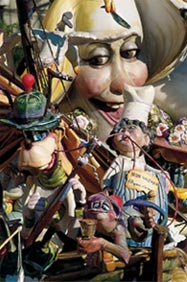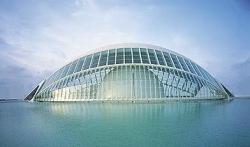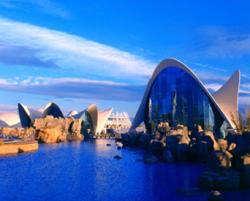
The city on the shores of the Mediterranean in the centre of the gulf of the same name is two thousand years old. Today two branches of the River Turia hold it in their embrace as the centre of the fertile region of orchard lands. It used to be the capital of the former Kingdom of Valencia encircled by walls until the 19th century and is the third largest city in todays Spain.
Valencia is an old city with a rich history, our ancestors have been a mixture of Phoenicians, Romans, Arabs, Jews and Christians. Such a mix has been the cause of the well-known open character of its people, that together with the many traditions, including the famous festival Las Fallas, the Wonderful Mediterranean weather, the tasty typical food dishes and the beauty of the land itself makes it a very attractive place.

Las Fallas is the most important festival in Valencia, celebrated from 15th to 19th March. During this week nearly 400 enormous statues built out of plaster are raised in the streets of Valencia. They receive the name of Falla and almost every street has one. They are satires on the problems facing modern society, poking fun at politicians or celebrities in Spain or the Valencian region. They are designed and financed by the 400 casal falleros, societies made up by members of each neighbourhood, and worked on during the whole year. The last night of the festival, March 19th, all the statues are lit on fire in the most spectacular display. It symbolizes the destruction of life's difficulties during last year and symbolizes also the celebration of the return of the spring. During this week, the streets of Valencia are packed with open air concerts, paella-cooking events, firecracker displays every day at 2pm (called Mascletás), fireworks every night (culminating in an enormous display on 19th called la Nit de Foc), and non-stop parties. The atmosphere is amazing and almost constant during the whole day and night. Also, in the Plaza de la Virgen a huge statue of the Virgin Mary is build up of flowers.
The historic centre of the city lies around the Cathedral. Splendid symbols of the cultures gone by are: The Metropolitan Cathedral which was begun in 1262, preserves Gothic structures in La Puerta de los Apostoles (Entrance Gate of the A.), in the Chapter House of the Holy Chalice and in the Lanter, and Romanesque ones in La Puerta del Palau, while the main entrance and the presbytery are Baroque. The octagonal Gothic belfry of the cathedral is affectionately known as El Micalet (little Michael). It dates from the 14th and 15th century and is the landmark of the city. The Royal Basilica of Our Lady of Los Desamparados, the 15th century Gothic image of the patron saint of Valencia and its people. Vault painting in fresco by Palomino. The regional government palace (Palau de la Generalitat) combines several styles. Renaissance coffering with Arab traces. Assembly Hall (Salon de Cortes) with paintings by Zariñena. La Bayla Palace, 16th century Gothic, seat of the provincial government, and La Scala Palace in the same style, but with Renaissance additions, are being refurbished. Both are apart of the building complex on Manises Square.
The best preserved remains of Islamic Valencia are Abd-al-Malikīs Baths, more widely known as Baños del Almirante (Admiralīs Baths). There are also some houses in Salinas St where traces of the Arab presence can still be found. In this area, fragments of the former wall can also be seen. In the course of this itinerary, one should stop at El Portal de Valldigna, visit the 14 century Serranos Towers, the former entrance gates to the city and protected today as a historic site, the 15th century Les Roques House, where the triumphal carriages of the Valencia Corpus processions are kept today, the 15th century Royal Monastery of La Trinidad at the beginning of Alboraya St as well as the Bridges and Parapets along the old bed of Turia, which were built between the 16th and 18th century and some of which are of undeniable artistic value.
Other interesting examples of Gothic religious buildings are the 14th century Church of San Juan del Hospital, which was built by the Hospitallers of St John of Jerusalem; Santo Domingo Convent founded as a result of the Reconquest, where San Vicente Ferrer used to live, today a military church, splendid Chapter House and Cloister; San Nicolas Parish Church with an art treasure well worth a visit; San Agustin P. Ch., where the bronze group above the lintel of the portal stands out, and Santa Catalina P. Ch. with an octagonal Baroque belfry held to be one of the most beautiful in Spain. Civil Gothic is especially well represented by the 15th century Lonja de Mercaders, an auction hall, built by Pere Compte and perhaps one of the best buildings in Europe. The hall with helicoidal columns and the rib vaulting will come as a pleasant surprise to the visitor. The Quart Towers of the middle of the 15th century used to be the entrance gate to the city for those who came from the lands of Castile.
Baroque are the Church of Los Santos Juanes (Sant Joan del Mercat), which faces La Lonja, San Juan de la Cruz with skirtings of glazed tiles from Manises and San Esteban where (according to the legend) El Cidīs daughters married and where San Vicente Ferrers font is kept. In the vicinity there are also the Palace of the Marquises of Dos Aguas, an old mansion (refurbished in the 18th century) with a Churrigueresque portal, the 16th century Graeco-Roaman Royal College of El Corpus Christi, more widely known as El Patriarca in reference to San Juan de Ribera, its founder, the University, where Juan Luis Vives, the universally famous native of Valencia, was a student, the 18th century Palace-cum-Monastery of El Temple, which is the seat of central government representation today. El Palacio de Justicia (the Law Courts), which is also of the 18th century and was originally meant to house the Customs, and the City Hall, which is a building of the beginning of the century with an important collection of incunables and illuminated books, such as the Consolat del Mar, the Llivre del Furs and the one of the Mustaçaf, La Senyera, the Peño de la Conquesta and the sword of Don Jaime el Conquistador. The Taula de Canvis and the paintings by Zariñena, Vergara, Vicente López, Sorolla, etc., deserve special mention.
Since there is not enough room to list all that remains to be described of this city of light, which so often has been called the cradle of art, special attention should be given at least to the House where San Vicente Ferrer was born, which is almost a place of pilgrimage for the people of Valencia, and the Cruces de Termino, crosses indicating the boundaries of municipal. Of Modernist architecture are the Bullring, El Norte Station, Colon Market and the Central Market, one of the best and largest in Europe.

A newly opened City of the Arts and Sciences in Valencia, features a planetarium called L'Hemisfèric and a science museum that both make extensive use of laminated glass to achieve a challenging and audacious architectural assembly, in the words of architect Santiago Calatrava, also of Valencia. The planetarium globe (shown on the right), which houses a viewing theatre, is roofed over by an elliptical shell structure of laminated glass and aluminum with longitudinal sections that can open to the sky. The globe is cradled like the pupil of an eye in a concrete socket, which is sheltered by the laminated glass pod. As soon as L'Hemisfèric was finished, Valencians nicknamed it the giant eye. The projection machine is an UNIVERSARIUM Model VIII TD, which turns the dome into a nightly sky with extremely bright and brilliant stars. Also installed are an Omnimax wide-angle movie projector, an Omniscan laser projector, and an excellent audiovisual system.

The city of the arts and sciences is certainly unique in the world, comprising a palace of the arts, a domed theater called L'Hemisfèric, a science museum, and an oceanographic park called L'Oceanogràfic (shown on the left). Designed by Spain's top architect Santiago Calatrava, the three buildings mentioned radiate lively freshness and bold elegance. The oceanographic park L'Oceanogràfic, is an underwater city designed by the late Felix Candela. The visitor is invited to walk through several habitats of the world, from the Artic Ocean to the Antartic, passing through the tropical latitudes of the Atlantic, Pacific, and Indian Oceans, including some temperate coastal Wetlands, and our Mediterranean Sea. It exhibits also the Europe's largest Dolphinarium.
Set in the old dried-up river bed of the Turia, midway between the old city of Valencia and the coastal district of Nazaret, the City of the Arts and Sciences covers an area of 350,000 square meters.
Click here for more information on Valencia and surroundings.